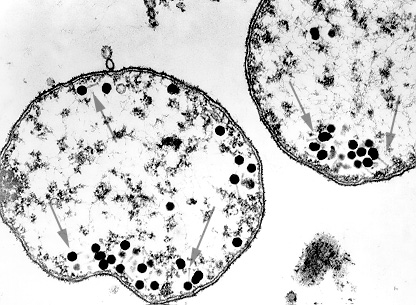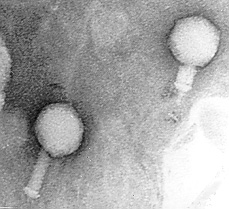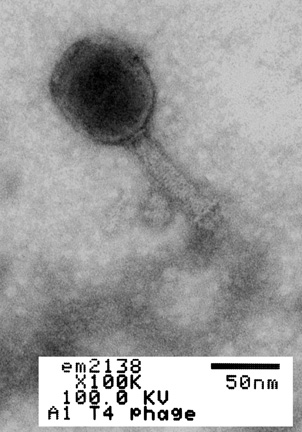11.1: Introduction
- Page ID
- 123429
Viruses are infectious agents with both living and non-living characteristics.
1. Living characteristics of viruses
a. They reproduce at a fantastic rate, but only in living host cells.
b. They can mutate.
2. Non-living characteristics of viruses
a. They are acellular, that is, they contain no cytoplasm or cellular organelles.
b. They carry out no metabolism on their own and must replicate using the host cell's metabolic machinery. In other words, viruses don't grow and divide. Instead, new viral components are synthesized and assembled within the infected host cell.
c. With few exceptions, they possess DNA or RNA but never both.
Viruses are usually much smaller than bacteria. Most are submicroscopic, ranging in size from 10-250 nanometers.
Structurally, viruses are much more simple than bacteria. Every virus contains a genome of single-stranded or double-stranded DNA or RNA that functions as its genetic material. This is surrounded by a protein shell called a capsid or core composed of protein subunits called capsomeres. Many viruses consist of no more than nucleic acid and a capsid, in which case they are referred to as nucleocapsid or naked viruses.
Most animal viruses have an envelope surrounding the nucleocapsid and are called enveloped viruses. The envelope usually comes from the host cell's membranes by a process called budding, although the virus does incorporate glycoprotein of its own into the envelope.
Bacteriophages are viruses that infect only bacteria (see Fig. \(\PageIndex{1A}\)). In addition to the nucleocapsid or head, some have a rather complex tail structure (see Fig. \(\PageIndex{1B}\)) used in adsorption to the cell wall of the host bacterium (see Fig. \(\PageIndex{1C}\)). A Transmission electron micrograph of the coliphage T4 can be seen in Fig. \(\PageIndex{1D}\).
|
Fig \(\PageIndex{1A}\): Bacteria infected with Bacteriophages |
Fig. \(\PageIndex{1B}\): Transmission Electron micrograph of a bacteriophage with a contractile sheath |
Fig. \(\PageIndex{1C}\): Bacteriophage Structure (Coliphage T-4) |
Fig \(\PageIndex{1D}\): Transmission Electron Micrograph of Coliphage T4 |
|---|---|---|---|
 |
 |
 |
 |
| Most of the phages (arrows) have assembled | Left = normal bacteriophage Right = bacteriophage after contraction of sheath |
||
| © Courtesy of Dr. Robert Burchard Used with permission. |
© Courtesy of Dr. Robert Burchard Used with permission. |
Copyright; Gary E. Kaiser, Ph.D. The Community College of Baltimore County, Catonsville Campus CC-BY-3.0 | Image courtesy of Louisa Howard. Public domain. Dartmouth EM Facility |
Since viruses lack organelles and are totally dependent on the host cell's metabolic machinery for replication, they cannot be grown in synthetic media. In the laboratory, animal viruses are grown in animals, in embryonated eggs, or in cell culture. (In cell culture, the host animal cells are grown in synthetic medium and then infected with viruses.) Plant viruses are grown in plants or in plant cell culture. Bacteriophages are grown in susceptible bacteria.
Today we will be working with bacteriophages since they are the easiest viruses to study in the lab. Most bacteriophages, such as Coliphage T4 that we are using today, replicate by the lytic life cycle and are called lytic bacteriophages.
Contributors and Attributions
Dr. Gary Kaiser (COMMUNITY COLLEGE OF BALTIMORE COUNTY, CATONSVILLE CAMPUS)

